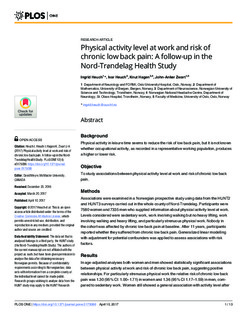| dc.contributor.author | Heuch, Ingrid | |
| dc.contributor.author | Heuch, Ivar | |
| dc.contributor.author | Hagen, Knut | |
| dc.contributor.author | Zwart, John-Anker | |
| dc.date.accessioned | 2018-06-05T11:01:39Z | |
| dc.date.available | 2018-06-05T11:01:39Z | |
| dc.date.created | 2017-04-18T09:09:55Z | |
| dc.date.issued | 2017 | |
| dc.identifier.citation | PLoS ONE. 2017, 12 (4), 1-13. | nb_NO |
| dc.identifier.issn | 1932-6203 | |
| dc.identifier.uri | http://hdl.handle.net/11250/2500323 | |
| dc.description.abstract | Background: Physical activity in leisure time seems to reduce the risk of low back pain, but it is not known whether occupational activity, as recorded in a representative working population, produces a higher or lower risk. Objective: To study associations between physical activity level at work and risk of chronic low back pain. Methods: Associations were examined in a Norwegian prospective study using data from the HUNT2 and HUNT3 surveys carried out in the whole county of Nord-Trøndelag. Participants were 7580 women and 7335 men who supplied information about physical activity level at work. Levels considered were sedentary work, work involving walking but no heavy lifting, work involving walking and heavy lifting, and particularly strenuous physical work. Nobody in the cohort was affected by chronic low back pain at baseline. After 11 years, participants reported whether they suffered from chronic low back pain. Generalized linear modelling with adjustment for potential confounders was applied to assess associations with risk factors. Results: In age-adjusted analyses both women and men showed statistically significant associations between physical activity at work and risk of chronic low back pain, suggesting positive relationships. For particularly strenuous physical work the relative risk of chronic low back pain was 1.30 (95% CI: 1.00–1.71) in women and 1.36 (95% CI 1.17–1.59) in men, compared to sedentary work. Women still showed a general association with activity level after adjustment for education, leisure time physical activity, BMI, smoking and occupational category. In men, the higher risk was only maintained for particularly strenuous work. Conclusion: In this cohort, women had a higher risk of chronic low back pain with work involving walking and heavy lifting or particularly strenuous work, compared to sedentary work. Men participating in particularly strenuous work also experienced a higher risk of chronic low back pain. | nb_NO |
| dc.language.iso | eng | nb_NO |
| dc.publisher | PLOS | nb_NO |
| dc.rights | Navngivelse 4.0 Internasjonal | * |
| dc.rights.uri | http://creativecommons.org/licenses/by/4.0/deed.no | * |
| dc.title | Physical activity level at work and risk of chronic low back pain: A follow-up in the Nord-Trøndelag Health Study | nb_NO |
| dc.type | Journal article | nb_NO |
| dc.type | Peer reviewed | nb_NO |
| dc.description.version | publishedVersion | nb_NO |
| dc.source.pagenumber | 1-13 | nb_NO |
| dc.source.volume | 12 | nb_NO |
| dc.source.journal | PLoS ONE | nb_NO |
| dc.source.issue | 4 | nb_NO |
| dc.identifier.doi | 10.1371/journal.pone.0175086 | |
| dc.identifier.cristin | 1465196 | |
| dc.description.localcode | © 2017 Heuch et al. This is an open access article distributed under the terms of the Creative Commons Attribution License, which permits unrestricted use, distribution, and reproduction in any medium, provided the original author and source are credited. | nb_NO |
| cristin.unitcode | 194,65,30,0 | |
| cristin.unitname | Institutt for nevromedisin og bevegelsesvitenskap | |
| cristin.ispublished | true | |
| cristin.fulltext | original | |
| cristin.qualitycode | 1 | |

